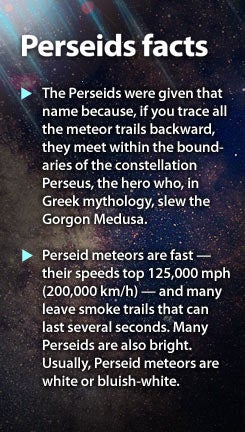
Astronomy‘s mission:
Astronomy promotes the science and hobby of astronomy through high-quality publications that engage, inform, entertain, and inspire.
More resources from Astronomy.com:
- Astronomy news
- Astronomy basics
- Glossary of astronomical terms
- Return to Astronomy “For the media” page
WAUKESHA, Wis. — Campers, early commuters, and casual sky observers can watch shooting stars in the predawn sky August 12 when one of the year’s best meteor showers peaks. Perseid meteors will rain down before sunrise. Viewers can expect to see 60 to 90 meteors per hour under a dark sky after the Moon sets in the early morning.
“This is a great event for the whole family,” says Astronomy magazine Senior Editor Michael Bakich. “Viewing a meteor shower doesn’t require any equipment, the event is active during a long period of time, and it happens in the summer.”
Astronomy magazine editors are available to explain how to observe the shower. To request an interview, please contact Matt Quandt at 262.798.6484 or mquandt@kalmbach.com.
The best time to spot the meteor sky show is around 1:30 a.m. local daylight time the day of the peak. If the forecast calls for cloudy skies August 12, look for a decent show a day or two before and after.
Bright, fast meteors, many leaving smoke trails visible for several seconds, characterize the Perseid meteor shower. The Perseids result when Earth runs into debris ejected by Comet 109P/Swift-Tuttle.
A dark sky provides the best conditions for viewing the shower. “Dark” skies are at least 40 miles away from light-polluted cities. This shower is best seen without a telescope or binoculars, because eyes alone provide the largest field of view.









